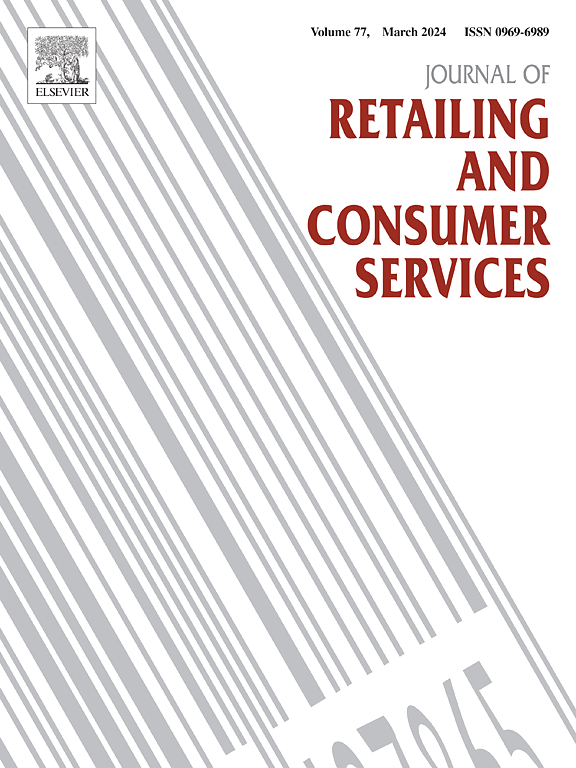A longitudinal big data approach to theorizing consumers' continuance intention to use loyalty apps
IF 13.1
1区 管理学
Q1 BUSINESS
Journal of Retailing and Consumer Services
Pub Date : 2025-08-11
DOI:10.1016/j.jretconser.2025.104453
引用次数: 0
Abstract
In an increasingly competitive fintech landscape, the ability to sustain user satisfaction and continuance intention beyond initial adoption is emerging as a resolute frontier. However, most prior studies have modeled continuance intention through survey-driven approaches and rarely explore organically expressed feedback in loyalty-centric fintech settings. This paper explores the nuances of post-adoption behaviors within fintech loyalty applications by analyzing the multilingual reviews posted by users on the app store as a way to mine their collective voice, or User Generated Content (UGC). Employing a sequential mixed-methods approach, we integrated confirmatory regression modeling of continuance behavior with topic modeling, sentiment analysis, hierarchical clustering, and Latent Dirichlet Allocation (LDA). Our analysis on 5669 app reviews revealed a dynamically-configured constellation of service quality, information quality, system quality, perceived usefulness, and evolving perceptions of risk. These elements enable user satisfaction and increase intention to continue using the service. It is worth mentioning that perceived risk silently acts as a dispositional control factor that can significantly erode loyalty away from positive user experiences. Merging classical theoretical approaches with unstructured user feedback enhances our understanding of loyalty within fintech in practice. This research provides a comprehensive framework to establish trust, satisfaction, and continuance use. These insights will enable developers, managers, and policy makers to forge resilient connections with users in a trust-scarce, value-starved, experience-saturated environment where lasting competitive advantage resides. We recommend that fintech loyalty platforms embed real-time feedback systems, visible security cues, and performance-aligned incentives to translate satisfaction into sustained user engagement.
一种纵向大数据方法来理论化消费者使用忠诚度应用程序的持续意愿
在竞争日益激烈的金融科技领域,在最初采用之后保持用户满意度和持续意向的能力正在成为一个坚定的前沿。然而,大多数先前的研究都是通过调查驱动的方法对延续意愿进行建模,很少探索以忠诚度为中心的金融科技环境中有机表达的反馈。本文通过分析用户在应用商店发布的多语言评论来挖掘他们的集体声音或用户生成内容(UGC),探讨了金融科技忠诚度应用中采用后行为的细微差别。采用顺序混合方法,我们将连续性行为的验证性回归建模与主题建模、情感分析、层次聚类和潜在狄利克雷分配(LDA)相结合。我们对5669个应用程序评论的分析揭示了服务质量、信息质量、系统质量、感知有用性和不断变化的风险感知的动态配置星座。这些元素使用户满意并增加继续使用服务的意图。值得一提的是,感知风险是一种潜在的控制因素,会严重侵蚀用户的忠诚度,使其远离积极的用户体验。将经典理论方法与非结构化用户反馈相结合,可以增强我们对金融科技实践中忠诚度的理解。本研究提供了一个建立信任、满意度和持续使用的综合框架。这些见解将使开发人员、管理人员和政策制定者能够在信任稀缺、价值匮乏、经验饱和的环境中与用户建立有弹性的联系,从而获得持久的竞争优势。我们建议金融科技忠诚度平台嵌入实时反馈系统、可见的安全提示和与绩效挂钩的激励措施,将满意度转化为持续的用户参与度。
本文章由计算机程序翻译,如有差异,请以英文原文为准。
求助全文
约1分钟内获得全文
求助全文
来源期刊
CiteScore
20.40
自引率
14.40%
发文量
340
审稿时长
20 days
期刊介绍:
The Journal of Retailing and Consumer Services is a prominent publication that serves as a platform for international and interdisciplinary research and discussions in the constantly evolving fields of retailing and services studies. With a specific emphasis on consumer behavior and policy and managerial decisions, the journal aims to foster contributions from academics encompassing diverse disciplines. The primary areas covered by the journal are:
Retailing and the sale of goods
The provision of consumer services, including transportation, tourism, and leisure.

 求助内容:
求助内容: 应助结果提醒方式:
应助结果提醒方式:


